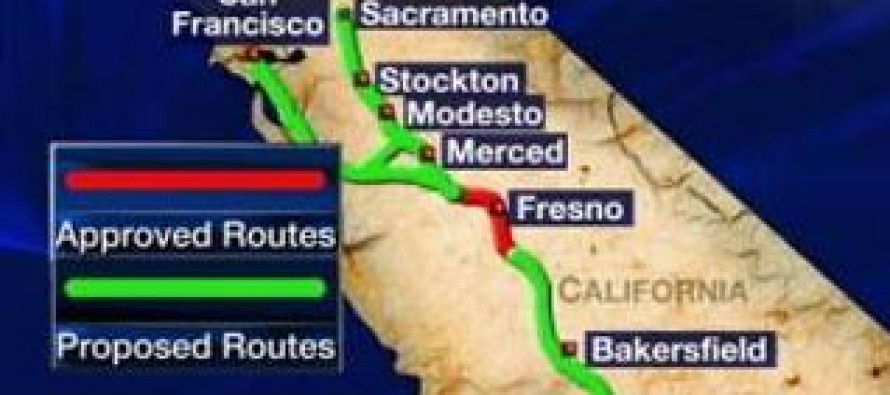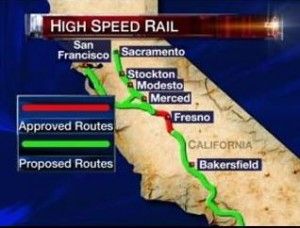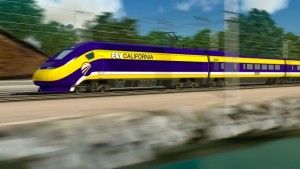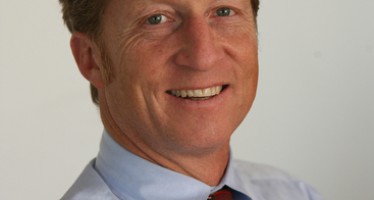LAO: Bullet train could increase greenhouse gases by 2020

 Gov. Jerry Brown’s plan to spend the lion’s share of cap-and-trade auction revenue on the high-speed rail project won’t help the state meet its goal of reducing greenhouse-gas emissions by 2020, according to a recent Legislative Analyst’s Office report. It could actually make things worse during construction.
Gov. Jerry Brown’s plan to spend the lion’s share of cap-and-trade auction revenue on the high-speed rail project won’t help the state meet its goal of reducing greenhouse-gas emissions by 2020, according to a recent Legislative Analyst’s Office report. It could actually make things worse during construction.
Brown wants to spend $250 million of the $850 million cap-and-trade revenue expected in the 2014-15 fiscal year on high-speed rail construction. After that he wants one-third of all cap-and-trade revenue to be spent on high-speed rail.
The revenue could total around $15 billion by 2020, according to the LAO, citing economists’ estimates. That would provide about $5 billion for high-speed rail by 2020 with funding continuing until the project is done.
Construction creates at least 30,000 metric tons of GHG
AB32, the California Global Warming Solutions Act of 2006, requires California to reduce its greenhouse-gas emissions to 1990 levels by 2020.
But spending $5 billion of cap-and-trade money on the bullet train won’t do anything to meet that target, because the train won’t be operational until 2022. In the meantime, its construction is expected to produce 30,000 metric tons of greenhouse-gas emissions, according to the LAO.
Thousands of trees will be planted in the Central Valley to offset those emissions. But that might not be enough, according to the LAO.
The official estimate of high-speed rail construction emissions does “not include emissions associated with the production of construction materials, which suggests that the amount of emissions requiring mitigation could be much higher than currently planned,” the report states.
“Therefore, it is possible that the construction of the IOS [initial operating segment] may result in a net increase in greenhouse-gas emissions, even when accounting for proposed offsets.”
 Legislators concerned
Legislators concerned
State legislators, including some Democrats, are concerned that Brown’s cap-and-trade spending plan shortchanges other programs that could actually help the state meet its 2020 greenhouse-gas target. Many are concerned that the cap-and-trade revenue will not be spent cost-effectively.
And some are concerned that California’s struggling residents and businesses will be hit hard as cap-and-trade ratchets up the cost of energy in coming years.
“I’m from the Inland Empire. Many businesses are having a tough time getting permits to expand and grow their business,” said Sen. Norma Torres, D-Pomona, at the Feb. 13 Senate Budget and Fiscal Review Committee hearing. “We have double-digit unemployment. So I know that my community is paying into this program to fund all of these feel-good, look-good, long-term issues.”
Administration defends bullet train spending
California Transportation Agency Secretary Brian Kelly defended the prioritization of high-speed rail in Brown’s spending plan, saying it will pay off in the long run. He cited a high-speed rail line from Madrid to Seville in Spain that accounts for 90 percent of the trips in that route.
“The investment of cap-and-trade funds in the development of high-speed rail in California is, in our view, an appropriate use of these funds due to the transformative nature of the project and the corresponding reduction in greenhouse-gas emissions from operating a high-speed rail system,” Kelly said.
“Greenhouse-gas benefits of this mode shift are dramatic. On a per-passenger, per-mile basis, high-speed rail emits a fraction of the greenhouse gas compared to more carbon-intensive bus, automobile and air travel.”
Spending cap-and-trade revenue on high-speed rail does present a risk of a legal challenge, said Cara Horowitz, executive director of the Emmett Center on Climate Change and the Environment at UCLA Law School. But she doesn’t consider it a significant risk.
“The touchstone legal question is: Do the funds facilitate the reduction in greenhouse-gas emissions?” Horowitz said. “And projects are generally riskier if it’s harder to show that they will in fact result in greenhouse-gas emission reductions. So [for example] if there’s a project that only has marginal greenhouse-gas reductions benefit or they occur far, far out in the future.
“In the budget today, the risk is probably greatest for high-speed rail. But the risk is not so great. I think high-speed rail is not a risky project to spend funds on legally speaking. It will reduce greenhouse-gas emissions in the medium term if not the short term, and those reductions will be significant.”
Horowitz added that the state isn’t obligated to spend AB32 revenue cost-effectively or in ways that it would maximize greenhouse-gas reductions.
“The state has a significant amount of legal flexibility in choosing how to spend the funds,” she said.
An ‘art’ to the spending
State officials have apparently taken advantage of that flexibility in carving up how the money would be spent.
“Admittedly there was a little bit of an art to it,” said Department of Finance Assistant Program Budget Manager Matt Almy. “There were a lot of different factors and lenses and considerations. This art was informed by science.”
But the scientific method might not have been rigorously adhered to. There is little information on how much each cap-and-trade-funded program is expected to reduce greenhouse-gas emissions.
There was a desire “to get funding out the door for projects on the ground quickly,” said Almy. “One of the reasons we are funding a lot of existing programs was for that reason. Some programs have methodologies in place. The budget includes positions for ARB [Air Resources Board] to develop and refine those. And then there’s a reporting mechanism.”
But waiting a year to report the results of the cost-effectiveness of the programs concerns both the LAO and nearly every member on the Senate budget committee, including Chairman Mark Leno, D-San Francisco.
“It might make sense to have metrics developed before funds are actually distributed,” Leno said. “It’s important to maximize the greenhouse-gas emission reductions. It would seem logical to make sure that those metrics are in place before we even determine how they should be spent. And then use metrics to measure the success of those programs.”
Any GHG benefit for $250M?
Sen. Tom Berryhill, R-Modesto, sought to pin down Kelly on the benefit of spending $250 million in the next year on high-speed rail construction.
“It is my concern, and the concern of our [Republican] caucus, that the cap-and-trade program is going to be extracting billions of dollars out of our economy,” Berryhill said. “It’s an economy that is still struggling to recover, certainly in the Central Valley for sure. All of this in order to implement a plan that contains actually very little information on actual greenhouse-gas emission reductions that will be achieved.
“So my question is: Is the $250 million for high-speed rail, for environmental planning, right-of-way acquisition and construction, are the benefits of this $250 million as they relate to reducing greenhouse-gas emissions, are they actually quantified anywhere in this program? Have you got a best guess as to exactly what those emission reductions are going to be?”
Kelly responded, “On a dollar-per-dollar basis with the first $250 million, I do not.”
There is a similar lack of cost-benefit information for much of the rest of the $600 billion in cap-and-trade revenue that Brown plans to spend in the next year. It divides into three areas:
- Transportation and sustainable communities – $600 million, including: $250 million — high-speed rail; $200 million — low-emission vehicle rebates; $100 million — transit oriented development; $50 million — intercity rail.
- Clean energy and energy efficiency – $140 million, including: $80 million — weatherization in low-income communities; $20 million — energy efficiency upgrades in state buildings; $20 million — reducing agricultural waste; $20 million — water efficiency.
- Natural resources and waste diversion – $110 million, including: $50 million — fire prevention and urban forestry; $30 million — wetlands restoration; $30 million — waste diversion.
Who gets the bill?
While state officials are anticipating the cash infusion coming their way, Berryhill is worried about the forgotten man who gets stuck with the tab. He asked analyst Tiffany Roberts, “Do you have any concerns for the impacts on small businesses what this AB 32 is going to have with the fees and fines and revenue loss?”
Roberts responded that the LAO has not analyzed the impact on small businesses, but she guaranteed that there will be an impact.
“We would just say that as you move forward, you would want to think about the impact of the program as a whole in terms of economy wide impact,” Roberts said. “To the extent that you put a price on carbon, you are by design increasing the cost of energy.
“So the intent of the program is to send a price signal. So to the extent that you are doing that, entities will feel that, whether they are consumers, ratepayers, businesses or the economy as a whole.”
Berryhill said, “Oh, they are definitely going to feel it. I mean, there’s many different small businesses that are going to get hurt by this thing, if not ruined. But one in specific, the trucking industry, what this AB32 is basically doing to our trucking industry – there will be no small truckers. Because no one can afford the retrofits and everything else that’s going on.
“So I think you’re going to see, instead of us trying to help the small business sectors, we are killing the small business sectors. And it’s going to make everything big, corporate America before this thing is said and done.”
The best use of cap-and-trade funds would be to return them to the state’s largest greenhouse-gas producing companies and agencies that are paying into it, said Dorothy Rothrock representing the California Manufacturers and Technology Association.
“The monies are coming to you from manufacturers who are already struggling in this state to maintain very competitive operations,” she said. “It’s not clear that they can pass those costs onto customers. So they are often having to absorb those costs in their operations.
“We don’t believe that AB32 grants authority to auction allowances to ARB. If it is allowed, there may be constraints on the use of those funds to get the benefit back to the source of those monies. We think that sending those monies back to manufacturers to use to reduce their emissions to meet the AB32 goals would be the tightest nexus between the source of the money and a good use in AB32. It will minimize your litigation risk.”
Senate Budget Subcommittee No. 2 has scheduled a hearing for April 3 to consider Brown’s cap-and-trade spending plan in more detail.
Related Articles
Southern Califiornia’s new pact with the Delta water devil
July 30, 2012 By Wayne Lusvardi If you dine with the Sacramento Delta water devil, you better have a long
Do Californians want to raise oil taxes?
Are Californians ready for another tax increase? That’s what California hedge-fund manager Tom Steyer sought to find out in his “People’s
LA and SF dogfight over transport visions
In San Francisco, a bus project over a decade in the making finally receives its massive environmental impact report. In




